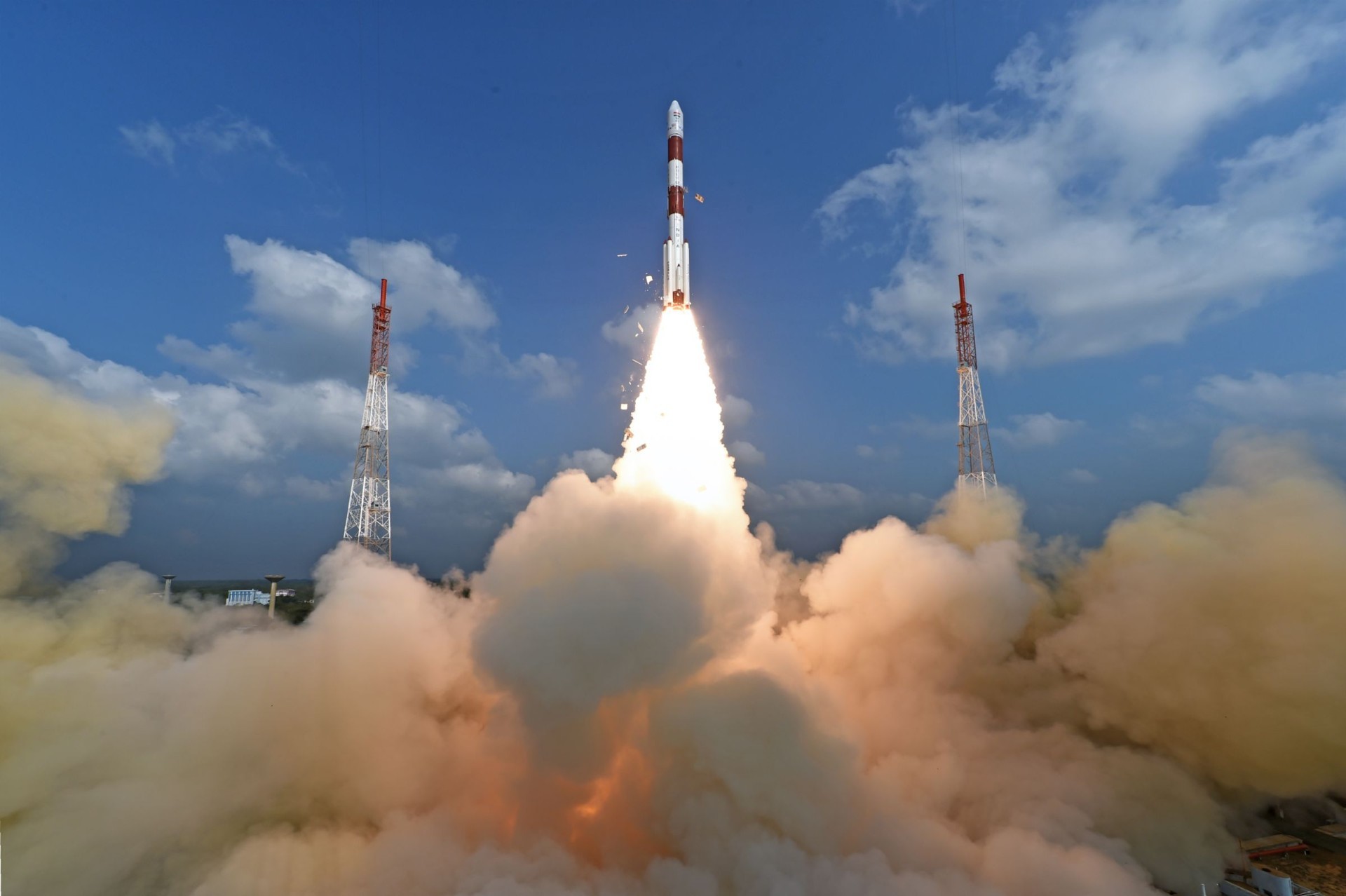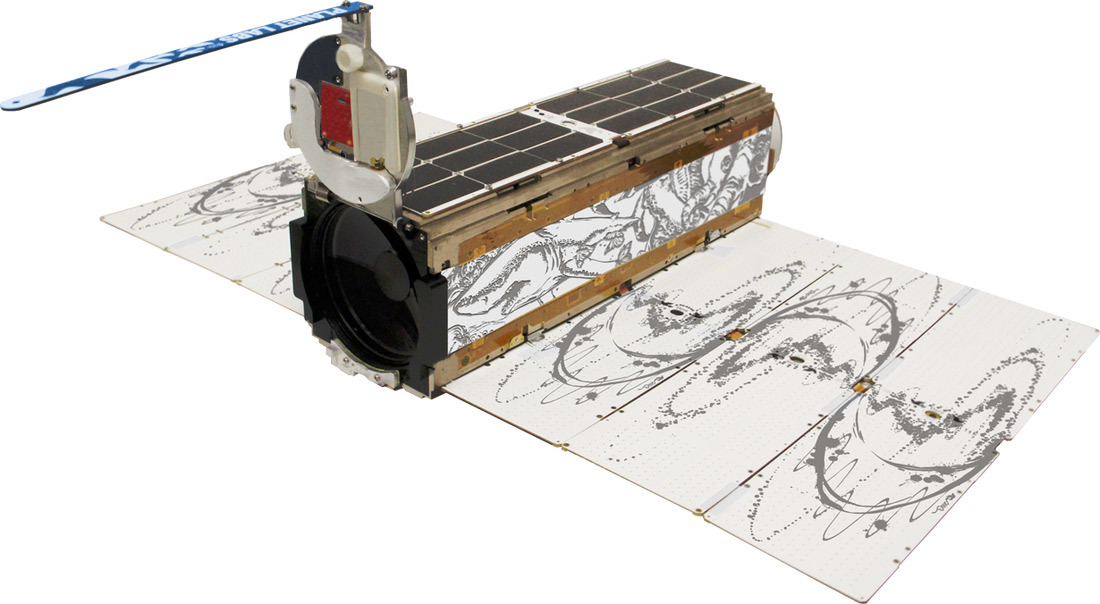India launched 104 satellites on one rocket - a new world record

Photo: Indian Space Research Organization
February 15, 2017 at 3:58 GMT (9:28 local time) from the space center of the Space Center. Satish Dhavana on Sriharikot Island in the Bay of Bengal in the south of Andhra Pradesh successfully launched the PSLV-XL launch vehicle - an improved standard PSLV (Polar Satellite Launch Vehicle) modification.
After 17 minutes 30 seconds after the launch of the PSLV-C37, the first satellite was released at an altitude of 510,383 km, and after 28 minutes 43 seconds at the altitude of 524,075 km, the last one, a total number of satellites, 104 pieces, with a total weight of 1378 kg, were output. The release of all satellites took more than 11 minutes, including 101 nanosatellites - 10 minutes 10 seconds. The previous record for the number of satellites was set by the Russian Space Agency on June 20, 2014 (37 satellites) on the Russian-Ukrainian launch vehicle Dnepr.
In the improved version of the PSLV-XL, the starting mass is increased to 320 tons and the increased side solid-fuel accelerators PSOM-XL are used.
')
The main load of the PSLV-C37 was a satellite series Cartosat-2D weighing 712 kg. This device alone weighs more than all other PSLV-C37 satellites.

Cartosat-2
This satellite is similar to the three previous satellites of the Cartosat-2 series and is intended for cartography and observation of Indian territory. It is equipped with a 70-centimeter telescope, a panchromatic high-resolution photodetector (65 cm per pixel), as well as a photo-receiver in the visible and near-infrared ranges with a resolution of 2 m per pixel.
Besides it, two more Indian microsatellites INS-1A and 1B, as well as 101 CubeSat-type nanosatellites from different customers from six countries of the world, were put into orbit.

INS-1A, CAD model
The INS-1A is equipped with a radiometer to measure the reflection of various types of the Earth’s surface, as well as instruments for monitoring the operation of electronics under radiation conditions in near-earth orbit. They are made with the same bus modules (developed in India) for simplified and cheap installation of the same nanosatellites from third-party customers. It is assumed that the launch of cheap satellites will be popular with customers from developing countries.
According to the official brochure , in addition to the above three Indian vehicles, the following satellites are installed on the launch vehicle (all in CubeSat format):
• DOVE (Flock-3P), USA - 88 pieces, each weighing 4.7 kg. Designed by the American company Planet Inc. for remote sensing of the Earth on the order of commercial customers, for environmental and humanitarian purposes.

A pair of DOVE satellites after launch from the ISS
Three-module satellites Flock-3P measuring 30 × 10 × 10 cm perform mainly commercial orders with multichannel imaging of the earth's surface with a resolution of 3-5 m per pixel. Until today's launch of Planet Inc. launched 175 such satellites, of which 133 were lost in the process of launching or deploying in orbit.


On two photos - satellites Flock-3P
For such cheap satellites a large percentage of losses is not a hindrance. The current launch of Planet Inc. not only seriously increased her grouping in orbit (although it is not yet known how many devices will actually start functioning), but also set a world record for the simultaneously derived grouping of satellites from one operator. A good example for Ilona Mask, who is going to output dozens of satellites at a time for a global satellite communications system consisting of 4425 satellites .
• LEMUR, USA - 8 pieces, weighing 4.6 kg each. Meteorological satellites (GPS, vertical profiles of temperature and humidity in the atmosphere) will complement the Spire Global constellation up to 29 satellites.
In addition to the three Indian and 96 American satellites, the launch vehicle launched five “cubes” from international customers.
• PEASS, the Netherlands - 3 kg. Developed by a European consortium of companies Innovative Solutions In Space BV to demonstrate the performance of a unified nanosatellite platform.
• DIDO-2, Switzerland - 4.2 kg. Microgravity studies in the field of biochemistry, biotechnology and microphysics for the Swiss company SpacePharma.
• BGUSat, Israel - 4.3 kg. Demonstration of the performance of the nanosatellite platform. Developed by Israeli Aerospace Industries (IAI) in conjunction with the University. Ben Gurion.
• AI-Farabi-1, Kazakhstan - 1 kg. Demonstration of the performance of the nanosatellite platform. Developed by Kazakhstan National University. al-Farabi.
• Nayif-1, United Arab Emirates - 1.1 kg. Demonstration of the performance of the nanosatellite platform. Designed by the Space Center. Mohammed Ibn Rashid in Dubai.
Kubsat customers are installed in 25 QuadPack containers of 12 units (four three-module satellites each).

A long row of QuadPack containers with “cubsat” before installation on the PSLV-XL launch vehicle. Photo: ISIS (Innovative Solutions in Space)
Russian participation
It is worth noting that the Russian aerospace industry was also involved in the record launch of the Indian space research organization. The fact is that on one of 104 satellites (on a CubeSat type satellite) three VHF transceivers of various manufacturers are installed. So, one of the three VHF transceivers and the VHF range antenna was made by the Russian company Sputnix . Sputnix transceiver tuned to 435.550 MHz.
Source: https://habr.com/ru/post/401613/
All Articles